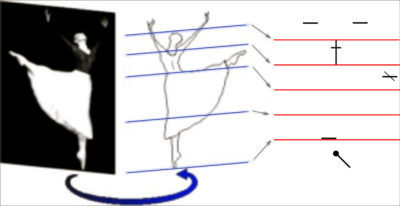From Editors to eBooks: Our Computer Journey
Rhonda Ryman-Kane and Robyn Hughes Ryman are Canadian-based choreologists who have created a series of fun, interactive ebooks to introduce dancers and theatre artists to Benesh notation and complement BI workshops, courses, and online resources.
We met in London in 1980 while Rhonda was completing her course work at the Benesh Institute (BI) and Robyn was working there awaiting her landed immigrant papers so she could join the National Ballet of Canada as Choreologist. It was the beginning of the personal computer age, and BI Director Monica Parker was dreaming of a computerised editor for Benesh notation. Coincidentally Rhonda was a professor at the University of Waterloo, one of Canada’s foremost computer science schools. The final act of fate was Rhonda introducing Robyn to her brother, Arthur, a software engineer. When they married, our Ryman family team was complete and our “baby,” the MacBenesh Editor, was conceived shortly thereafter. Our work on MacBenesh continued until the early 1990s when the BI began developing its PC-based Benesh Notation Editor (BNE).
Meanwhile, Rhonda was becoming interested in the rising field of computer animation, and conceived a project to create a multimedia dictionary of ballet, including Benesh notation and animation, as well as word descriptions. She began using choreography software now known as DanceForms. Compiling word definitions led to the publication of the Royal Academy of Dancing Dictionary of Classical Ballet Terminology in 1995, but the idea of creating interactive resources on Benesh notation continued to percolate. Eventually Robyn went back to school to complete a Masters degree where she gained expertise in video editing, creating web resources, and working with graphics programs. She began creating interactive online resources to teach children Benesh stage locations, and hosting forums where notators could share ideas and post questions. By the time Apple Computers introduced the iPad in 2010, our team had most of the pieces in place. Robyn began exploring iBooks Author, the application for creating ebooks for iOS devices, and we began our journey.
In creating the Benesh for Ballet ebook series, we targeted RAD students and teachers who wanted to read the notation included in the Set Exercises and Variations resources. Our goal was to make reading notation fun – to help a computer-savvy generation learn at their own pace, using technology familiar to them. We took advantage of features that encouraged individual study and exploration – features like hyperlinks within the ebook and to outside websites, self-correcting reviews, study cards, and interactive puzzles.
Our first ebook focused on static positions, with cross-references to Cecchetti, RAD, and Vaganova terms. We wanted to illustrate how easily notation clarifies vocabulary, especially when similar positions have different names across these schools. Books 2 and 3 presented basic theory for jumps, centre work, and also Benesh rhythm notation – a topic difficult to cover in traditional book format. We used animations and sound recordings to clarify how notation and musical accompaniment are sychronised. Book 4 introduced travel and staging information useful to dancers and theatrical stagers alike, reinforced by interactive puzzles coded by Robyn’s husband, Arthur.
Although the series focuses on reading notation, we believe that learning to write helps reinforce theory. We have created Writing Worksheets to accompany each ebook so that interested students can practise at their own pace. These Writing Worksheets are available for free download from this website.
